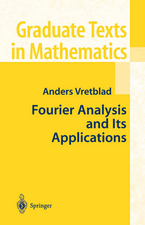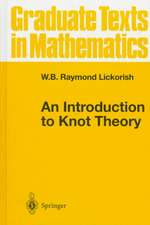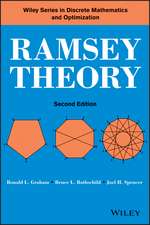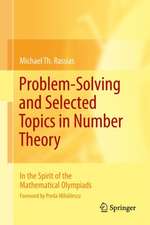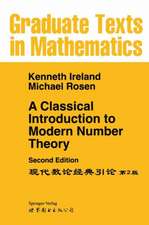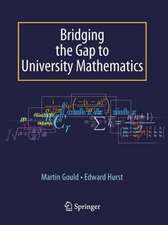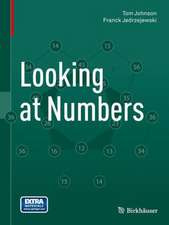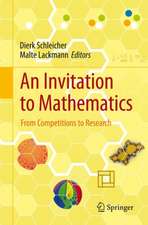Mathematics Is Not a Spectator Sport
Autor George Phillipsen Limba Engleză Hardback – 15 iul 2005
This book introduces the reader to various topics in mathematics and is intended for precocious high school students and college students just beginning their study of mathematics. The topics discussed in this book include a variety of results in number theory involving squares, and also complex numbers, early algebraic ideas such as the Euclidean algorithm, geometrical constructions created by the Greeks, and more recent topics such as group theory.
| Toate formatele și edițiile | Preț | Express |
|---|---|---|
| Paperback (1) | 378.08 lei 43-57 zile | |
| Springer – 5 oct 2010 | 378.08 lei 43-57 zile | |
| Hardback (1) | 383.74 lei 43-57 zile | |
| Springer – 15 iul 2005 | 383.74 lei 43-57 zile |
Preț: 383.74 lei
Nou
Puncte Express: 576
Preț estimativ în valută:
73.44€ • 76.29$ • 61.00£
73.44€ • 76.29$ • 61.00£
Carte tipărită la comandă
Livrare economică 03-17 februarie 25
Preluare comenzi: 021 569.72.76
Specificații
ISBN-13: 9780387255286
ISBN-10: 0387255281
Pagini: 240
Ilustrații: XIV, 240 p. 68 illus.
Dimensiuni: 152 x 235 x 18 mm
Greutate: 0.5 kg
Ediția:2005
Editura: Springer
Colecția Springer
Locul publicării:New York, NY, United States
ISBN-10: 0387255281
Pagini: 240
Ilustrații: XIV, 240 p. 68 illus.
Dimensiuni: 152 x 235 x 18 mm
Greutate: 0.5 kg
Ediția:2005
Editura: Springer
Colecția Springer
Locul publicării:New York, NY, United States
Public țintă
Lower undergraduateCuprins
Squares.- Numbers, Numbers Everywhere.- Fibonacci Numbers.- Prime Numbers.- Choice and Chance.- Geometrical Constructions.- The Algebra of Group.
Recenzii
From the reviews:
"The title of this book is an aphorism known by many concerned with the education of mathematicians, at many different levels. It is appropriate at all levels from primary school children ‘investigating’ to postgraduates generating and attempting to solve new problems. … The suggested audience is senior students in high school, students just beginning mathematics at university, and general readers no longer formally studying mathematics … . The content and style of the book matches this quite well and realistically." (John Baylis, The Mathematical Gazette, Vol. 91 (520), 2007)
"In this book, the author develops some (easy) mathematical concepts, which are suitable for high school students or non-mathematicians disciplines … . Each of the seven chapters is an invitation to learn new mathematical concepts. … The book is carefully written and a pleasure to read. … It is … an excellent prize to honor high school students for some extraordinary work in mathematics." (Alexander Pott, Zentralblatt MATH, Vol. 1140, 2008)
"The title of this book is an aphorism known by many concerned with the education of mathematicians, at many different levels. It is appropriate at all levels from primary school children ‘investigating’ to postgraduates generating and attempting to solve new problems. … The suggested audience is senior students in high school, students just beginning mathematics at university, and general readers no longer formally studying mathematics … . The content and style of the book matches this quite well and realistically." (John Baylis, The Mathematical Gazette, Vol. 91 (520), 2007)
"In this book, the author develops some (easy) mathematical concepts, which are suitable for high school students or non-mathematicians disciplines … . Each of the seven chapters is an invitation to learn new mathematical concepts. … The book is carefully written and a pleasure to read. … It is … an excellent prize to honor high school students for some extraordinary work in mathematics." (Alexander Pott, Zentralblatt MATH, Vol. 1140, 2008)
Notă biografică
George Phillips is Professor of Mathematics at St. Andrews University, Scotland. He is the author of two previous books also published by Springer, Two Millenia of Mathematics (2000), and Interpolation and Approximation by Polynomials (2003).
Textul de pe ultima copertă
Mathematics Is Not a Spectator Sport challenges the reader to become an active mathematician. Beginning at a gentle pace, the author encourages the reader to get involved, with discussions of an exciting variety of topics, each placed in its historical context, including:
* The surprising achievements of early Babylonian mathematics;
* The fascinating arithmetic of continued fractions;
* Geometric origins of the Euclidean algorithm;
* Infinite sets and the pioneering work of Georg Cantor;
* The sieve of Eratosthenes, which is used for finding primes;
* Gauss's conjecture about the density of primes;
* Special methods for finding really large primes, and a discussion of the famous Riemann hypothesis;
* A combinatorial interpretation of the Fibonacci numbers;
* A study of properties of the triangle, including one named after Napoleon;
* The application of algebraic methods to solve geometrical problems;
* The study of symmetries using algebraic methods;
* The foundations of group theory;
* An algebraic interpretation of the Platonic solids.
The chapters are largely self-contained and each topic can be understood independently. However, the author draws many connections between the various topics to demonstrate their interplay and role within the context of mathematics as a whole. Lots of carefully chosen problems are included at the end of each section to stimulate the reader's development as a mathematician.
This book is intended for those beginning their study of mathematics at the university level, as well as the general reader who would like to learn more about what it means to "do" mathematics.
* The surprising achievements of early Babylonian mathematics;
* The fascinating arithmetic of continued fractions;
* Geometric origins of the Euclidean algorithm;
* Infinite sets and the pioneering work of Georg Cantor;
* The sieve of Eratosthenes, which is used for finding primes;
* Gauss's conjecture about the density of primes;
* Special methods for finding really large primes, and a discussion of the famous Riemann hypothesis;
* A combinatorial interpretation of the Fibonacci numbers;
* A study of properties of the triangle, including one named after Napoleon;
* The application of algebraic methods to solve geometrical problems;
* The study of symmetries using algebraic methods;
* The foundations of group theory;
* An algebraic interpretation of the Platonic solids.
The chapters are largely self-contained and each topic can be understood independently. However, the author draws many connections between the various topics to demonstrate their interplay and role within the context of mathematics as a whole. Lots of carefully chosen problems are included at the end of each section to stimulate the reader's development as a mathematician.
This book is intended for those beginning their study of mathematics at the university level, as well as the general reader who would like to learn more about what it means to "do" mathematics.
Caracteristici
Compared to other popular math books, there is more algebraic manipulation, and more applications of algebra in number theory and geometry Presents an exciting variety of topics to motivate beginning students May be used as an introductory course or as background reading Includes supplementary material: sn.pub/extras

